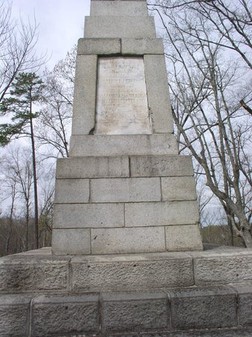Kings Mountain Centennial Monument
Introduction
Text-to-speech Audio
Images
Battle of Kings Mountain Centennial Monument
.jpg)
Side inscription on Battle of Kings Mountain Centennial Monument
.jpg)
Side inscription on Battle of Kings Mountain Centennial Monument
.jpg)
Front inscription on Battle of Kings Mountain Centennial Monument
.jpg)
Rear inscription on Battle of Kings Mountain Centennial Monument

Backstory and Context
Text-to-speech Audio
In 1780, the Revolutionary War raged in the Carolinas between those who favored independence and British Loyalists. In some ways the conflict represented a civil war as colonist fought against colonist. Leading up to the Battle of Kings Mountain, British commander, Major Patrick Ferguson attempted to gain support for the crown during the summer, as he traveled through South Carolina and North Carolina. In September, General Lord Charles Cornwallis led British troops to invade North Carolina. Cornwallis then ordered Ferguson to North Carolina to help safeguard his troops from rebel militia attacks. Patriot leaders including Colonels Charles McDowell, Isaac Shelby, John Sevier and William Campbell gathered on September 25 along the Watauga River at Sycamore Shoals in what later became Tennessee. Their troops then marched toward Gilbert Town and British Major Ferguson, gaining additional frontiersmen along the way.
On October 6, Major Ferguson, now camping at Kings Mountains, received news the Patriots were close behind him. He sent a message to General Cornwallis requesting additional troops. Ferguson tried to prepare for the enemy and establish a defense. Patriot troops now at Cowpens in South Carolina learned Ferguson was camped nearby at Kings Mountain. Additional men from South Carolina joined the Patriot troops and they marched all night toward Kings Mountain. Colonel William Campbell led the Patriot troops of 900 men. Around 3 pm on October 7, 1780, the fighting began at the Battle of Kings Mountains. Colonels Campbell and Shelby marched troops up the mountain as other patriot troops provided support until they reach the summit. The fighting lasted nearly an hour when Major Ferguson was killed. The Loyalist’s second in command ordered his troops to surrender and hoist the white flag. This brief battle resulted in 225 Loyalist casualties and 28 Patriot causalities.
The Kings Mountain Centennial Association purchased land around the Kings Mountain battlefield site and raised funds to construct the Centennial Monument. Construction began on June 23, 1880 with the laying of the cornerstone. The Masons placed a copper box inside the stone that included documents about the Kings Mountain celebrations of the past and present. The Kings Mountain Centennial Monument stands twenty-eight foot tall and is constructed of granite and marble. Each of four sides of the pylon have inscriptions.
On the 150th Anniversary of the Battle of Kings Mountain, President Herbert Hoover addressed at large crowd at the battlefield site stating, “It was a little army and a little battle, but it was of mighty portent. History has done scant justice to its significance, which rightly should place it beside Lexington and Bunker Hill, Trenton and Yorktown, as one of the crucial engagements in our long struggle for independence.”3
Sources
The Battle of King's Mountain, TheAmericanRevolution.org. Accessed April 30th 2020. http://theamericanrevolution.org/battledetail.aspx?battle=25.
Larson, Jennifer L.. Kings Mountain: A South Carolina Skirmish Becomes a Defining Moment in American History, Documenting the American South. Accessed April 30th 2020. https://docsouth.unc.edu/highlights/kingsmountain.html.
Address on the 150th Anniversary of the Battle of Kings Mountain, The American Presidency Project. Accessed April 30th 2020. https://www.presidency.ucsb.edu/documents/address-the-150th-anniversary-the-battle-kings-mountain.
Kings Mountain Centennial Monument, NCPedia. Accessed April 30th 2020. https://www.ncpedia.org/monument/kings-mountain-centennial.
https://www.tripadvisor.com/LocationPhotoDirectLink-g60876-d293595-i264662136-Kings_Mountain_National_Military_Park-Blacksburg_South_Carolina.html
https://www.tripadvisor.com/Attraction_Review-g60876-d293595-Reviews-Kings_Mountain_National_Military_Park-Blacksburg_South_Carolina.html#photos;aggregationId=&albumid=&filter=7&ff=452751143
https://www.tripadvisor.com/ShowUserReviews-g60876-d293595-r747029831-Kings_Mountain_National_Military_Park-Blacksburg_South_Carolina.html#photos;aggregationId=101&albumid=101&filter=7&ff=351839249
https://www.tripadvisor.com/Attraction_Review-g60876-d293595-Reviews-Kings_Mountain_National_Military_Park-Blacksburg_South_Carolina.html#photos;aggregationId=101&albumid=101&filter=7&ff=452751141
https://www.tripadvisor.com/Attraction_Review-g60876-d293595-Reviews-Kings_Mountain_National_Military_Park-Blacksburg_South_Carolina.html#photos;aggregationId=101&albumid=101&filter=7&ff=103084849
